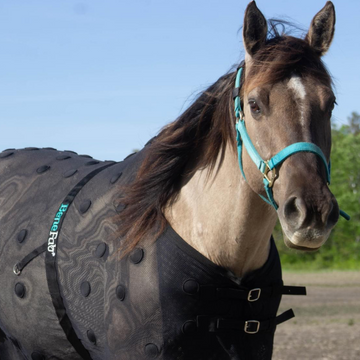 2. Coarse sand – Coarse sand is also a great footing. It is somewhat similar to gravel but it does not bind together. The coarse sand drains better and is less dusty than finer sands. This footing will not need to be replaced every year, as it does not break down. However, horses should NOT be fed on this type of footing as it can result in sand colic.
3. Hog fuel – Hog fuel is also known as chipped or shredded wood products. The wood tends to absorb some of the moisture in the ground, which helps to reduce mud. The downside to wood products is that they need to be replaced every year, as they tend to break down from the water.
Each type of footing has its own advantages and disadvantages so you will have to evaluate which footing is best for your paddocks. Keep in mind that you should use about three inches of footing for each pasture. Good luck and stay clean!
You can also check out our post on compost and manure management to help you get ready for spring!
For more information on different types of footing visit: http://cs.thehorse.com/blogs/smart-horse keeping/archive/2010/11/26/mud-management-102-paddock-footing.aspx
2. Coarse sand – Coarse sand is also a great footing. It is somewhat similar to gravel but it does not bind together. The coarse sand drains better and is less dusty than finer sands. This footing will not need to be replaced every year, as it does not break down. However, horses should NOT be fed on this type of footing as it can result in sand colic.
3. Hog fuel – Hog fuel is also known as chipped or shredded wood products. The wood tends to absorb some of the moisture in the ground, which helps to reduce mud. The downside to wood products is that they need to be replaced every year, as they tend to break down from the water.
Each type of footing has its own advantages and disadvantages so you will have to evaluate which footing is best for your paddocks. Keep in mind that you should use about three inches of footing for each pasture. Good luck and stay clean!
You can also check out our post on compost and manure management to help you get ready for spring!
For more information on different types of footing visit: http://cs.thehorse.com/blogs/smart-horse keeping/archive/2010/11/26/mud-management-102-paddock-footing.aspx
Blog
3 Types of Footing to Help Reduce Mud
3 Types of Footing to Help Reduce Mud By Emily Konkel
The thought of spring for most horse owners is wonderful; no more chipping frozen water buckets, no more blankets, longer days, warmer weather, the list goes on and on! However, there is one huge problem that also comes along with springtime – MUD! In most horse paddocks, mud is a common occurrence for this time of the year. Most horse owners believe that this is an inevitable part of spring but it does not have to be. Adding different types of footing to your pastures with a high traffic area (i.e., gates, watering areas, etc.) can help reduce mud. Here are three different types of footing that do this most efficiently:
1. Gravel – Gravel is a crushed rock that is a great footing to consider. The most ideal gravel shouldn't be larger than ¾”; larger gravel will be uncomfortable for horses to stand on. It drains very well and can bind together so it will not need to be replaced every year, which is a wonderful footing to help reduce mud. 2. Coarse sand – Coarse sand is also a great footing. It is somewhat similar to gravel but it does not bind together. The coarse sand drains better and is less dusty than finer sands. This footing will not need to be replaced every year, as it does not break down. However, horses should NOT be fed on this type of footing as it can result in sand colic.
3. Hog fuel – Hog fuel is also known as chipped or shredded wood products. The wood tends to absorb some of the moisture in the ground, which helps to reduce mud. The downside to wood products is that they need to be replaced every year, as they tend to break down from the water.
Each type of footing has its own advantages and disadvantages so you will have to evaluate which footing is best for your paddocks. Keep in mind that you should use about three inches of footing for each pasture. Good luck and stay clean!
You can also check out our post on compost and manure management to help you get ready for spring!
For more information on different types of footing visit: http://cs.thehorse.com/blogs/smart-horse keeping/archive/2010/11/26/mud-management-102-paddock-footing.aspx
2. Coarse sand – Coarse sand is also a great footing. It is somewhat similar to gravel but it does not bind together. The coarse sand drains better and is less dusty than finer sands. This footing will not need to be replaced every year, as it does not break down. However, horses should NOT be fed on this type of footing as it can result in sand colic.
3. Hog fuel – Hog fuel is also known as chipped or shredded wood products. The wood tends to absorb some of the moisture in the ground, which helps to reduce mud. The downside to wood products is that they need to be replaced every year, as they tend to break down from the water.
Each type of footing has its own advantages and disadvantages so you will have to evaluate which footing is best for your paddocks. Keep in mind that you should use about three inches of footing for each pasture. Good luck and stay clean!
You can also check out our post on compost and manure management to help you get ready for spring!
For more information on different types of footing visit: http://cs.thehorse.com/blogs/smart-horse keeping/archive/2010/11/26/mud-management-102-paddock-footing.aspx
 2. Coarse sand – Coarse sand is also a great footing. It is somewhat similar to gravel but it does not bind together. The coarse sand drains better and is less dusty than finer sands. This footing will not need to be replaced every year, as it does not break down. However, horses should NOT be fed on this type of footing as it can result in sand colic.
3. Hog fuel – Hog fuel is also known as chipped or shredded wood products. The wood tends to absorb some of the moisture in the ground, which helps to reduce mud. The downside to wood products is that they need to be replaced every year, as they tend to break down from the water.
Each type of footing has its own advantages and disadvantages so you will have to evaluate which footing is best for your paddocks. Keep in mind that you should use about three inches of footing for each pasture. Good luck and stay clean!
You can also check out our post on compost and manure management to help you get ready for spring!
For more information on different types of footing visit: http://cs.thehorse.com/blogs/smart-horse keeping/archive/2010/11/26/mud-management-102-paddock-footing.aspx
2. Coarse sand – Coarse sand is also a great footing. It is somewhat similar to gravel but it does not bind together. The coarse sand drains better and is less dusty than finer sands. This footing will not need to be replaced every year, as it does not break down. However, horses should NOT be fed on this type of footing as it can result in sand colic.
3. Hog fuel – Hog fuel is also known as chipped or shredded wood products. The wood tends to absorb some of the moisture in the ground, which helps to reduce mud. The downside to wood products is that they need to be replaced every year, as they tend to break down from the water.
Each type of footing has its own advantages and disadvantages so you will have to evaluate which footing is best for your paddocks. Keep in mind that you should use about three inches of footing for each pasture. Good luck and stay clean!
You can also check out our post on compost and manure management to help you get ready for spring!
For more information on different types of footing visit: http://cs.thehorse.com/blogs/smart-horse keeping/archive/2010/11/26/mud-management-102-paddock-footing.aspx





















